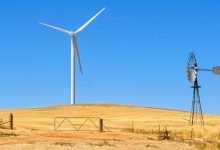South Australia’s conservative Liberal government has boasted that it has 10GW of large scale wind and solar projects now in the development pipeline, propelling the state towards its anticipated milestone of “net” 100 per cent renewables by 2030.
The accumulated total was revealed by state energy minister Dan van Holst Pellekaan as he welcomed approval for a 176MW solar and battery storage project near Murray Bridge in South Australia – the fifth such project to get the go-ahead in the state in a matter of weeks.
The $350 million Pallamana Solar Farm, by developers RES, received planning consent on Tuesday, keeping the project in step with the timeline detailed on its website.
The solar farm – to be located on 73 hectares of land around 60km south-east of Adelaide – will generate enough power to meet the needs of 82,000 homes, and also store “dispatchable” energy in lithium-ion battery banks, the company says.
Minister van Holst Pellekaan said in a statement that the state had an “unrivalled portfolio of renewable energy projects” with substantial wind and solar capacity already installed and a “great deal more on the drawing board”.
He noted that this would further enhance the economic and environmental credentials of the $1.5 billion SA-NSW interconnector proposed by Electranet and supported by both the state and the Australian Energy Market Operator, and which will be key to delivering the Liberal state government’s ambition of becoming a major exporter of renewable energy.
“The fact SA currently has some 10,000MW of solar and wind generation on the drawing board highlights the state’s potential to be a energy powerhouse,” van Holst Pellekaan said.
 South Australia currently sources more than half of its yearly electricity demand from renewables, mostly wind but a growing amount of large scale and rooftop solar too, and most new project proposals include battery storage, while at least four pumped hydro proposals are working through feasibility studies.
South Australia currently sources more than half of its yearly electricity demand from renewables, mostly wind but a growing amount of large scale and rooftop solar too, and most new project proposals include battery storage, while at least four pumped hydro proposals are working through feasibility studies.
Currently, in times of high wind output, the state has to ensure a certain amount of gas generators remain on line, but new “synchronous condensers” to be installed over the coming 12 months will remove this need, leading to lower prices and less curtailment.
The approach from the S.A. Liberal government contrasts completely with the federal Coalition government, which has more or less shut up shop since the May election result, which was such a surprise the government hadn’t actually bothered to formulate any medium to long-term energy or climate policy.
And the S.A. approach is attracting business. In comments quoted by the Advertiser, the project manager of the Pallamana Solar Farm, Chris Gosling, said RES was aiming to close financing for the PV and storage faciity in the first half of 2020, using a mix of debt and equity.
“We’re seeing quite a bit of investor interest in South Australia solar,” Gosling was quoted as saying. “And we’ve got a lot of parties out there seeking projects for potential offtake agreements.”
Pallamana is the latest in a series of major solar and battery storage projects to be approved for the state, including the 280MW Bungama Solar Farm, which was green-lighted just last week for development by EPS Energy near Port Pirie, alongside 140MW/560MWh of battery storage.
EPS Energy is also behind the Robertstown Solar project, which won state development approval just over two weeks ago, to install 500MW of PV and a 250MW/1000MWh battery north-east of Adelaide.
And the Solar River project by Jason May and Richard Winter – which will install 200MW of PV and “one of the largest” batteries in the Southern Hemisphere – landed a power purchase agreement with major utility, Alinta Energy, last Thursday.
For RES, the Pallamana project is not the company’s only project in the pipeline for South Australia, with plans to develop what would be one of Australia’s largest battery storage facilities – up to 50MW/215MWh – next to a new 183MW wind project north of Adelaide.
As we reported here in May, these plans have been edging closer to reality, despite ongoing local opposition to the ambitious project which is slated to be built near the state’s Barossa Valley.
South Australia’s State Commission Assessment Panel, which visited the Barossa Valley in May to meet with locals, resolved to grant development plan consent to the Twin Creek Wind Farm, subject to planning conditions, reserved matters and advisory notes.










